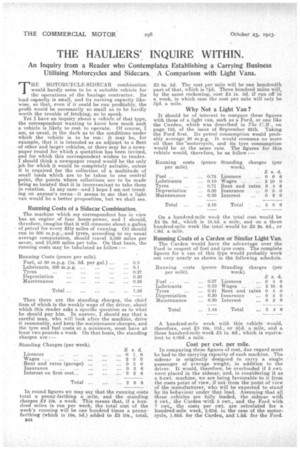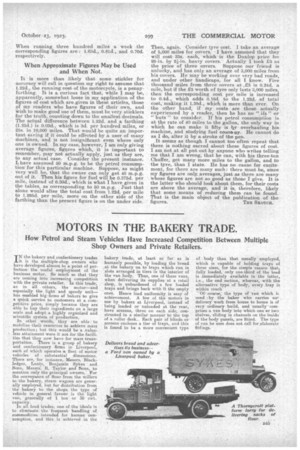THE HAULIERS' . INQUIRE WITHIN.
Page 26

Page 27

If you've noticed an error in this article please click here to report it so we can fix it.
An Inquiry from a Reader who Contemplates Establishing a Carrying Business Utilising Motorcycles and Sidecars. A Comparison with Light Vans.
r-jrHE MOTORCYCLE-SIDECAR combination would hardly seem to be a suitable vehicle for the operations of the haulage contractor. Its load capacity is small, and its earning capacity likewise, so that, even if it could be run profitably, the profit would be necessarily so small as to be hardly worth the trouble of fetching, so to speak.
Yet I have an inquiry about a vehicle of that type, the correspondent wanting to know how much such a vehicle is likely to cost to operate. Of course, I am; as usual, in the dark as to the conditions under which the vehicle is to be run : it may be, for example, that it is intended as an adjunct to a fleet of other and larger vehicles, or there may be a newspaper round for which a quotation has been invited, and for which this correspondent wishes to tender.
I should think a newspaper round would be the only job for which it would be completely suitable, unless it is required for the collection of a multitude of small loads which are to be taken to one central point, the paints where collections are to be made being so located that it is inconvenient to take them in rotation. In any ease-and I hope I am not treading on anyone's corns-it seems to ine that a light van would be a better proposition, but we shall see.
Running Costs of a Sidecar Combination.
• The machine which my correspondent has in view has an engine of four horse-power, and I should, therefore, imagine that it will consume about a gallon • of petrol for every fifty miles of running. Oil should run to 500 m.p.g.,&and tyres, according to my usual average computation, should travel 5,000 miles per cover, and 10,000 miles per tube. On that basis, the running costs may be tabulated as follow :
Then there are the standing charges, the chief item of which is the weekly wage of the driver, about which this reader asks a specific question as -to what he should pay him. In answer, I should say that a careful man, who will look after the machine, drive it reasonably, and keep the maintenance charges, and the tyre and fuel costs at a minimum, must have at least two pounds a week. On that basis, the standing in round figures we may say that the running costs total a, penny-farthing a mile, and the standing charges £2 10s. a week. This means that, if a hundred miles is run per week, the total cast of the week's running will be one hundred times a pennyfarthing (which is-10s, 5d.) added to £2 10s., total,
B44
£3 Os. 5d. The cost per mile will be one hundredth part of that, wfiich is 7id. Three hundred miles will, by the same reckoning, cost £4 is. 3d. if run off in a week, in which case thecost per mile will only be aid. a mile.
Why Not a Light Van?
It should be of interest to compare these figures with those of a light van, such as a Ford, or one like the Carden, which was described in The Cif. on page 155, of the issue pf September 25th. Taking the Ford first. Its petrol consumption would probably average 20 m.p.g. It would consume no more oil than the "Motorcycle, and its tyre consumption would be at the same rate. The figures for this vehicle would, therefore, be as follow :
Running costs (pence Standing charges (per per mile). week).
Fuel ... 0.75 Licences 0 6 6 Lubricants 0.10 Wages ... 2 10 0 Tyres 0.71 Rent and rates 0 4 6 Depreciation 0.30 Insurance 0 5 0 Maintenance 0,30 Interest 0 2 6 Total ,,, 2.16 Total ... 3 8 6
On a hundred-mile week the total cost wmild be
• £4 Os. 6d., which is 10.4d. a mile, and on a three hundred-mile week the total would be £6 2s. 6c1., or 4-9d. a mile.
Running Costs of a Carden or Similar Light Van.
The Carden would have the advantage over the Ford in respect of fuel and tyre costs. The complete figures for a van of this type would probably work out very nearly as shown in the following schedule.
A -hundred-mile week with this vehicle would, therefore, cost £3 16s. led., or 91d. a mile, and a, three hundred-mile week £5 is. 6d., which is equivalent to 4.06d. a mile.
Cost per cwt. per mile.
In comparing these figures of cost, due regard must be had to the carrying capacity of each machine. The sidecar is originally designed to. carry a single passenger of average weight, in addition to the driver. It would, therefore, be. overloaded if 2 cwt. were placed in the sidecar, and, in considering it as a 2-cwt. machine, we are being favourable to it from the costs point of view, if not from the point of view of the manufacturer, who will be expected to stand by its behaviour under that load. Assuming that all three vehicles are fully loaded, the sidecar with 2 cwt., the Carden with 5 cwt., and the Ford with 7 ewt'
, the costs per cwt. are calculated for a hundred-mile week, 3.63d. in the case of the motorcycle, 1.85d. for the Carden, and 1.5d. for the Ford.
When running three hundred miles a week the corresponding figures are : 1.63d., 0.81d., and 0.70d.
respectively. •
When Approximate Figures May be Used and When Not.
It is more than likely that some stickler for accuracy will call in question my right to assume that 1.22d., the running cost of the motorcycle, is a pennyfarthing. It is a curious fact that, while I may be, apparently, somewhat loose in my application of the figures of cost which are given in these articles, those of my readers who have figures of their own, and wish to make good use of them, must be very sticklers for the truth, counting down to the smallest decimals. The actual difference between 1.22d. and a farthing (1.25d.) is 0.0'3d., which is 3d. per hundred miles, or 25s. in 10,000 miles. That would be quite an important saving if it could be effected by a user of many machines, and is not insignificant even where only one is owned. In my case, however, I am only giving average figures, figures which, it is important to remember, may not actually apply, just as they are, to any actual case. Consider the present instance. I. have assumed 50 m.p.g. to be the petrol consumption for this particular machine. Suppose, as might very well be, that the owner can only get 40 m.p.g. out of it. Then his figure for fuel will be 0.375d. per mile, instead of 0.30d., which is what I have given in the tables, as corresponding to 50 m.p.g. Just that alone would alter the total cost from 1.22d. per mile to 1.295d. per mile, more on the other side of the farthing than the present figure is on the under side. Then, again. Consider tyre cost. I take an average of 5,000 miles for covers. -I have assumed that they will cost 33s. each, which is the Dunlop price for 26-in. by 24-in. heavy covers. Actually I took £5 as the price of three covers. Suppose our friend is unlucky, and has only an average of 3,000 miles from his covers. He may be working over very bad roads, and under other handicaps, for all I know. Five thousand miles from three covers at ,t 5 is 0.24d. a mile, but if the .25 worth of tyre only lasts 3,000 miles, then the corresponding cost per mile is increased to 0.4d., which adds 0.16d. to the 1.22d. of total Cost, making it 1.38d., which is more than ever. On the other hand, if my costs are those actually experienced by a reader, then he has no " ifs " or " buts " to consider. If his petrol consumption is at the rate of 40 miles to the gallon, the only way in which he can make it fifty is hy. overhauling his ma-chine, and studying fuel econo.ny. He cannot do as I do, alter it by a stroke of the pen. It seems as though I cannot too often repeat that there is nothing sacred about these figures of cost.
ani not at all put out by anyone who writes telling me that I am wrong, that he can, with his three-ton Chuffer, get many more miles to the gallon, and to the tyre, than I state. He has no cause for excitement, for there are many such : there must be, since my figures are only. averages, just as there are many whose figures are not so good as those I give. It is the latter who should look about them, for their costs are above the average, and it is, therefore, likely that some means of reducing them can be found. That is the main object of the publication of the
figures. Tuz S1COTCH.






























